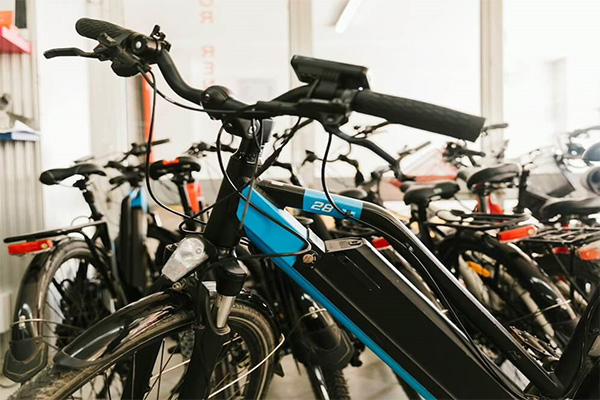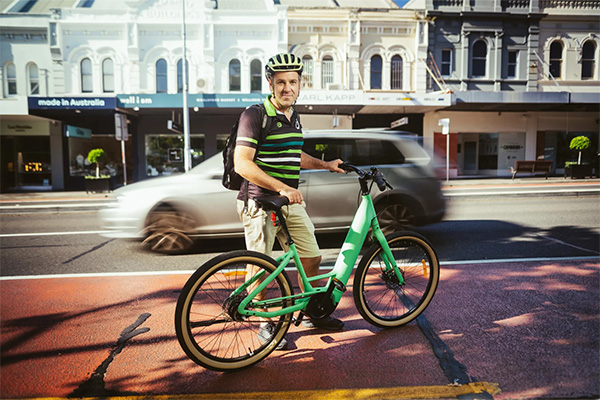Stories of spectacular fires caused by lithium-ion batteries have sparked fears about the safety of these batteries and the gadgets they power. And of course, this includes e-bikes and other e-mobility devices.
As our recent article Why is there an e-bike in my shower? highlighted, e-bikes are very popular with people living in apartments. Of course, e-bikes and e-scooters are not responsible for all fires. But pressure is mounting on strata committees across Australia to address concerns and mitigate risks.
E-bikes are a very popular, affordable and practical transport option for apartment dwellers in denser urban areas. And Bicycle NSW is passionate about supporting uptake. (Image: Electric Bike Superstore)
Earlier this month, the Owners Corporation Network (OCN), an independent body representing apartment owners in Australia, announced that they had drafted a model by-law on the management of e-bikes and e-scooters.
Why are lithium-ion batteries causing problems?
Lithium-ion batteries are relatively new on the market. They were first introduced in the 1990s with improvements to storage capacity in the early 2000s. This led to a rapid growth in the market. Compared with lead-acid batteries, lithium-ion batteries charge faster and store more energy. They are lighter and last longer.
The batteries are now used in mobile phones, laptops and tablets, power tools, vapes, watches, vacuum cleaners and even kids’ toys. They are a central component of renewable energy storage systems and, of course, electric cars. And they have enabled a booming micro-mobility market.
But, in October 2023, the Australian Competition and Consumer Commission (ACCC) released a report warning consumers about rare but serious fire hazards from lithium-ion batteries.
ACCC Deputy Chair Catriona Lowe said, “We are concerned by increasing reports of lithium-ion battery fires resulting in property damage and serious injuries, including burns, chemical exposure and smoke inhalation.”
Are they really that dangerous?
All batteries are energy-dense and contain material that is highly flammable. So fires tend to be more intense and explosive when batteries are involved. Batteries are more likely to catch fire when exposed to heat and moisture, or if crushed. All common conditions in garbage trucks and household waste facilities! This is one of the reasons we should separate batteries from the rest of our household waste.
As a denser source of energy than lead-acid batteries, lithium-ion battery fires tend to be more explosive. When they fail, the violent bursting of one or multiple battery cells, can produce a hissing sound and release toxic, flammable and explosive gases. This creates an intense, self-sustaining fire that is difficult to extinguish. It is called a ‘thermal runaway event’.
That sounds pretty scary. Firefighting agencies are particularly concerned about electric vehicle collisions as very large batteries are involved.
So what are the risks?
The main risk is with poorly manufactured devices that may contain defects, inadequate safety provisioning and contamination introduced during manufacture. This can lead to short-circuiting, battery cell malfunctions or system faults. Devices modified at home using recycled parts can be the riskiest.
There are additional risks associated with how the battery is maintained, such as:
- overcharging or use of non-compliant charging equipment
- overheating or exposure to heat or extreme temperatures
- physical abuse (e.g., dropping, crushing, piercing, and/or vibrations)
Much of the media attention conflates lithium-ion battery fires with e-bikes and e-scooters, which is not necessarily accurate. Fire and Rescue NSW reported that e-mobility devices caused a quarter of all battery fires in NSW during 2023.
But if a lithium-ion battery is properly maintained and meets all the required regulations, the risk of it spontaneously catching fire is very low.
The risks of lithium-ion batteries in laptops, mobile phones and other devices, even some electric toothbrushes, need to be understood and managed as well. Look out for the warning signs that something is not quite right, such as swelling, a cracked case, or overheating (Image: Purdue University)
How can we move forward?
“We need to take a risk- and evidence-based approach to e-bikes,” says Peter McLean, Bicycle NSW CEO. “They are a wonderful transport tool which pose little risk when they are good quality, high standard and maintained appropriately.”
Vilifying e-mobility and lithium-ion batteries is problematic as our current vision for a renewable energy future is very reliant on lithium-ion batteries to store energy.
Dr Matthew Priestley from the Energy Systems Research Group at University of NSW has highlighted that lithium-ion batteries are vital for a decarbonised transport system, and that the problems with them stem from lack of regulation rather than the batteries themselves.
“It’s important that the public and industry do not perceive it to be dangerous,” Dr Priestly says. “But at the moment, most people do not have an adequate understanding about the risks associated with these batteries, or enough respect for them.”
What must governments do?
In Australia, the regulations surrounding lithium-ion batteries vary state to state. As a result, there are many loopholes. Poorly manufactured batteries end up in products for sale.
The ACCC report advocates for a mandatory safety standard for products containing lithium-ion batteries. A nationally consistent regulatory framework must be developed as soon as possible with clear requirements for the testing, labelling, transportation, storage, recycling and disposal of lithium-ion batteries.
In addition, it is essential to tackle the community’s limited knowledge about battery safety.
The ACCC has argued that consumers need accessible guidance on the practical steps they can take to help mitigate safety risks:
- how to select, use, store and dispose of lithium-ion batteries safely
- how to identify when batteries are at risk of being unsafe
- practical steps and risk mitigation strategies consumers can take to help stay safe.
To help inform future policy, Fire and Rescue NSW will undertake lithium-ion battery fire tests to clarify the risks of each product and identify the most effective extinguishing methods.
What is Bicycle NSW doing?
To this end, Bicycle NSW is pressuring state and federal ministers to prioritise the development of battery safety regulations and education campaigns, in line with the ACCC recommendations.
This includes mandating a single universal charging plug for e-bikes. Standardised chargers will be more convenient for users, but also safer. This is because chargers regulate battery temperature, voltage and other parameters. When these parameters are variable there is greater chance of mismatched products which can have dangerous outcomes. A similar situation used to plague EV safety. Since May 2019, almost every EV in Australia has been sold with a standard 2-pin plug.
Bicycle NSW has provided a submission to the NSW Parliament’s Inquiry into Electric and Hybrid Vehicle Batteries. We urged NSW Government to collect accurate data about the cause of fires to ensure a strong evidence base for future legislation around e-mobility devices. We are concerned that non-evidence-driven policy and regulation will jeopardise tourism, grow inequity and discriminate against less abled people and those who may not have access to other forms of transport.
Bicycle NSW CEO Peter McLean believes e-bikes have potential to transform mobility and decarbonise transport systems (Image: Dion Georgopoulos/SMH)
Bicycle NSW is also engaging with the Owners Corporation Network to ensure we have fair and proportionate strata bylaws, which are based on real risks and solid evidence. Following Bicycle NSW feedback, the draft bylaws were amended to be more practical, given that every building is different.
Despite media headlines, no ban is being proposed in strata bylaws. The focus will be on promoting safe charging and storage, and encouraging residents to buy good quality e-bikes.
Complexes which try to impose bans will leave themselves open to legal challenge as strata bylaws can’t be ‘harsh, oppressive or unconscionable’.
“We shouldn’t over-react,” says Peter McLean. “E-bikes are the missing piece in the transport puzzle – they enable people of all ages and experiences to access active transport. The real problem is that the federal government was not preventing cheap, no-compliant e-bikes, which can retail for as little as $500, from being imported and sold, even though they don’t meet Australian safety standards.
What can the consumer do?
The ACCC report made several recommendations that are useful for e-bike owners:
- Only consider an e-bike that is certified to the UL2849 standard
- Buy your e-bike from a reputable supplier who can help maintain it.
- Always follow the manufacturers guidelines for charging the battery
- Store e-bikes in cool, dry places away from direct sunlight, including while charging
- Ensure your bike and battery are regularly maintained and serviced by a professional
- Do not use lithium-ion devices if products are overheating or showing signs of failure such as swelling, leaking or venting gas.
- Allow time for batteries to cool down after use and before recharging
- Keep an appropriate chemical fire extinguisher in an accessible place
Our friends at Lug+Carrie have written a great guide to e-bike battery safety. Rest assured that the Tern e-bikes used by Lug+Carrie subscribers are certified to the gold standard of e-bikes and batteries – UL2849. The batteries are manufactured by Bosch - a brand synonymous with high quality manufacturing, safety and reliability. When it comes to safety, Tern leaves no stone… un-Terned! (Image: Lug+Carrie)
There is more good advice on the Fire and Rescue NSW website here.
It is also important to ensure that all batteries are disposed of responsibly. Recycling guidelines can be found on the NSW EPA website here and your local council should be able to help.
What can strata committees do?
Strata committees could provide information about how to safely maintain lithium-ion batteries in any device, not just a bike or e-scooter. Infographics and simple advice in multiple languages is suggested.
Unit complexes should provide safe bike storage and charging facilities so it is more convenient for occupants to store and maintain their bikes outside of apartments.
So should we ban e-bikes from apartments?
No. The danger is from the battery, not the bike. And given the variety of everyday devices that now contain lithium-ion batteries, it is not consistent to ban bikes over other items such as smartphones and vacuum cleaners.
However, we urgently need better federal and state regulations to keep everyone safe, as well as consumer education about batteries.
If you are not a Bicycle NSW member, please join up today. You will help support our advocacy work with all levels of government to make NSW better for bike riding!





